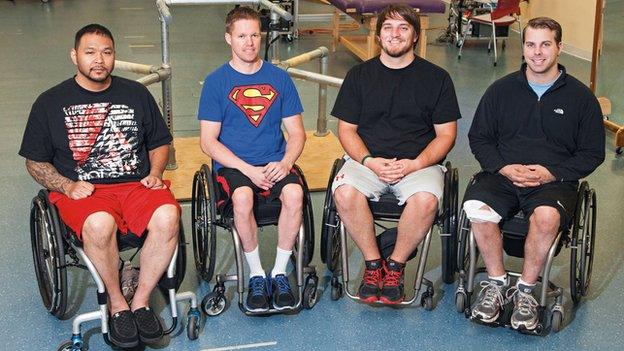Paralysed men move again with spinal stimulation
- Published

Andrew Meas, Dustin Shillcox, Kent Stephenson and Rob Summers were treated at the University of Louisville's Kentucky Spinal Cord Injury Research Centre.
Four paralysed men have been able to move their legs for the first time in years after electrical stimulation of their spinal cords, US doctors report.
They were able to flex their toes, ankles and knees - but could not walk independently.
A report, in the journal Brain, suggests the electricity makes the spinal cord more receptive to the few messages still arriving from the brain.
Experts said it could become a treatment for spinal injury.
The spinal cord acts like a high-speed rail line carrying electrical messages from the brain to the rest of the body. But if there is any damage to the track, then the message will not get through.
People with spinal cord injuries can lose all movement and sensation below the injury.
Zap
A team at the University of Louisville and the University of California have been pioneering electrical stimulation of the spinal cord below the injury.
Three years ago they reported that Rob Summers - a keen baseball player who was paralysed from the chest down in a hit-and-run car accident - was able to move his legs while supported on a treadmill.
Now three more patients, who had been paralysed for at least two years, have gone through the procedure and regained some movement.
Four men in the US, who are paralysed, are able to move their legs with a spinal zap
They were able to control their legs at a precise pace and all but one of them were able to control the force of the movement.
It confirms that function can be restored after paralysis and that Mr Summers' case was not a one-off.
One of the researchers, Dr Claudia Angeli from the University of Louisville, told the ģÉČËŋėĘÖ: "They will tell you that the stimulation itself and being able to practise and move around makes them feel a lot better, some of them will just describe it as feeling alive again."
"Muscle mass increases significantly and they've all shown changes in bowel and bladder [function] as well."
It is not certain how the stimulation helps, however the researchers believe that some signals are still crossing the injury, but are not normally strong enough to trigger movement.
The electrical stimulation made the lower spinal cord more excitable so it was able to respond when the messages did arrive from the brain.
Dr Angeli described it as "making it ready to listen".
Progress
Half of the patients still had some sensation in their legs, but could not move them. The other two had no feeling either.
Dr Mark Bacon, the director of research at the charity Spinal Research, told the ģÉČËŋėĘÖ: "The fact that paralysed patients with some preserved sensation can regain a degree of voluntary control when receiving electrical stimulation to the cord, is amazing.
"The fact that this can be demonstrated in patients with so-called 'complete' injuries, where there is total loss of muscle and sensation is, on the face of it, remarkable."
He said it showed that even in these patients there is are still some functioning nerves crossing the spinal injury.
"Significantly, it does strongly suggest that other repair treatments in development may only need to achieve relatively rudimentary additional connections between the brain and the cord below the injury to access functional capacity which will improve quality of life."
Dr Roderic Pettigrew, director of the US National Institute of Biomedical Imaging and Bioengineering, said: "Now that spinal stimulation has been successful in four out of four patients, there is evidence to suggest that a large cohort of individuals, previously with little realistic hope of any meaningful recovery from spinal cord injury, may benefit from this."
Susan Howley, from the Christopher and Dana Reeve Foundation which funds spinal cord injury research, said the study confirmed Mr Summers' case was "not an anomaly".
She added: "The implications of this study for the entire field are quite profound and we can now envision a day where epidural stimulation might be part of a cocktail of therapies used to treat paralysis."
- Published20 May 2011